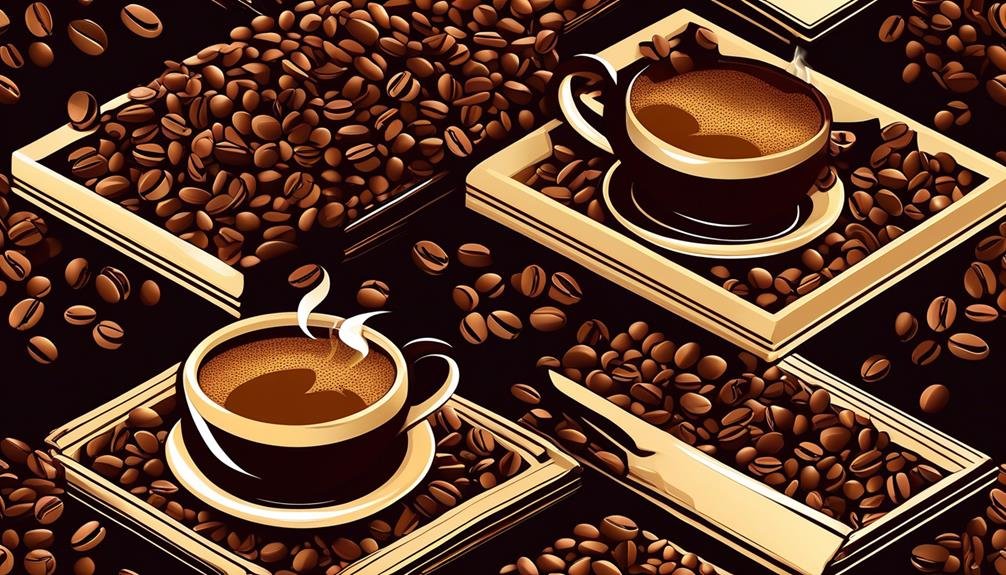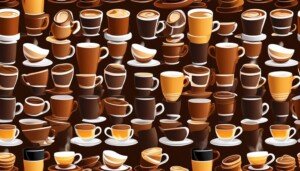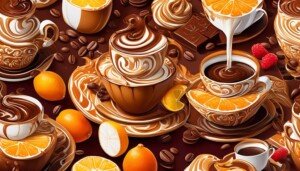You've probably heard the age-old saying, 'There's more than meets the eye.' Well, that certainly holds true when it comes to espresso and coffee.
While they both fall under the realm of caffeinated beverages, the differences between the two are quite remarkable. From the brewing methods to the flavor profiles, there is a world of disparity waiting to be explored.
So, grab a cup of your favorite brew and get ready to discover the nuances that set espresso and coffee apart.
Key Takeaways
- Brewing methods such as French press, pour-over, espresso, AeroPress, and percolator have specific variables that impact the taste of the coffee.
- Flavor profiles in coffee are influenced by factors like origin, roast level, processing method, and bean variety.
- Espresso beans are roasted longer and darker, resulting in a robust and full-bodied flavor, while drip coffee beans are typically roasted to varying degrees of light, medium, and medium-dark roasts.
- Espresso has a higher caffeine content compared to regular brewed coffee, but the caffeine content can vary depending on various factors.
Brewing Methods
To understand the differences between espresso and coffee, it's essential to delve into the world of brewing methods. Brewing methods encompass a wide range of techniques such as French press, pour-over, espresso, AeroPress, and percolator. Each method involves specific variables like water temperature, grind size, and extraction time, resulting in distinct flavor profiles.
Espresso, for example, is brewed under high pressure and uses finely ground coffee, resulting in a concentrated and robust flavor. On the other hand, traditional coffee brewing methods like French press and pour-over rely on immersion and gravity to extract flavors, resulting in a more balanced and nuanced taste.
The choice of brewing method can significantly impact the body, acidity, and overall taste of the coffee. Some methods, like espresso, produce a rich and bold flavor, while others, like pour-over, highlight the subtle notes and aromas present in the coffee beans. Understanding brewing methods allows coffee enthusiasts to explore and appreciate the diversity of flavors that can be achieved through different extraction techniques.
Flavor Profiles
Now that we've explored the different brewing methods and how they can influence the taste of coffee, let's dive into the fascinating world of flavor profiles.
Flavor profiles are the unique combination of tastes, aromas, and sensory experiences found in different coffees. Different factors such as origin, roast level, processing method, and bean variety contribute to the flavor profile of a coffee. Coffee flavor profiles can include fruity, floral, nutty, chocolatey, spicy, earthy, or acidic notes, among others.
Understanding flavor profiles is crucial for selecting the right coffee that aligns with your taste preferences and brewing methods. It allows you to explore the vast array of flavors that coffee has to offer and enhances your overall coffee experience.
When it comes to espresso, the flavor profile tends to be more concentrated and intense compared to regular brewed coffee. Espresso often exhibits a bolder and richer taste with hints of dark chocolate, caramel, or even toasted nuts. The brewing process of espresso, which involves high-pressure extraction and a shorter brew time, contributes to its distinct flavor profile.
On the other hand, regular brewed coffee can have a wider range of flavor profiles depending on factors such as the origin of the beans, the roast level, and the brewing method used. This versatility allows for a more diverse and nuanced coffee experience, with the possibility of tasting fruity, floral, or even herbal notes in your cup.
Exploring and experimenting with different flavor profiles is an exciting journey that allows you to discover your personal preferences and expand your coffee palate. So go ahead and explore the world of coffee flavor profiles, and savor the unique tastes and aromas that each cup has to offer.
Roasting Differences

Espresso beans undergo a longer and darker roasting process compared to beans used for drip coffee, resulting in a robust and full-bodied flavor profile. The darkly roasted beans used for espresso are roasted to the point where the natural oils in the coffee beans are brought to the surface, giving them a shiny appearance. This dark roast creates a deep, rich flavor with notes of chocolate, caramel, and even a hint of smokiness.
To illustrate the difference in roasting between espresso and drip coffee, consider the following table:
| Roast Level | Espresso Beans | Drip Coffee Beans |
|---|---|---|
| Light | No | Yes |
| Medium | No | Yes |
| Medium-Dark | No | Yes |
| Dark (Espresso) | Yes | No |
As shown in the table, espresso beans are specifically roasted to the dark/espresso roast point, while drip coffee beans are typically roasted to varying degrees of light, medium, and medium-dark roasts.
The longer and darker roasting process for espresso beans not only affects the flavor but also the texture and body of the resulting espresso. The high heat during roasting causes the beans to become more porous, allowing for better extraction when hot water is forced through the tightly packed grounds. This creates a thick and velvety crema, a characteristic of a well-made espresso.
Caffeine Content
The caffeine content in espresso and coffee can vary depending on the quantity consumed. If you're a caffeine lover, you'll be interested to know the following facts about the caffeine content in espresso and coffee:
- An espresso shot contains around 50-60 milligrams of caffeine per ounce. This means that a single shot of espresso typically has about 50-60 milligrams of caffeine, making it a concentrated dose of energy.
- A double shot of espresso, which is commonly used as the base for many espresso-based drinks, may have about 120 milligrams of caffeine. So, if you're looking for a stronger kick, a double shot might be the way to go.
- On the other hand, brewed coffee tends to have a lower caffeine content. It can contain around 18 milligrams of caffeine per ounce. This means that an 8-ounce cup of brewed coffee can have 144 milligrams of caffeine content or more.
It's important to note that these numbers are just averages and can vary depending on factors such as the type of coffee bean, brewing method, and serving size. So, whether you prefer the intense and concentrated caffeine punch of espresso or the milder yet still energizing effect of brewed coffee, knowing the caffeine content can help you make the right choice to suit your needs.
Espresso Vs. Americano

If you're ready to explore the differences between espresso and Americano, let's dive into the world of concentrated coffee shots and their diluted counterparts.
Espresso is made by forcing hot water through finely ground coffee beans using high water pressure. This results in a concentrated shot of coffee that's rich, bold, and full-bodied. It's typically served in small quantities, usually 1-2 ounces, and has a top layer of foam called crema, which adds to its sensory experience.
On the other hand, Americano is made by diluting espresso with hot water. This dilution process creates a milder flavor compared to espresso. Americano is typically served in larger quantities, usually 6 ounces, and doesn't have crema.
The key difference between espresso and Americano lies in their taste profiles. Espresso has a bolder and more intense flavor due to its concentrated nature, while Americano has a lighter taste due to the dilution with hot water.
Espresso Vs. Cappuccino
When it comes to comparing espresso and cappuccino, one noticeable difference lies in their milk-to-coffee ratio. While espresso is primarily a shot of concentrated coffee, cappuccino is a combination of equal parts espresso, steamed milk, and milk foam.
Here are three key distinctions between espresso and cappuccino:
- Milk Texture: Cappuccino has a creamy and velvety texture due to the steamed milk and milk foam. On the other hand, espresso has a lighter mouthfeel and lacks the creamy texture of cappuccino.
- Flavor Profile: Cappuccino offers a balanced blend of espresso's boldness and the sweetness of milk, resulting in a rich and smooth taste. Espresso, with its concentrated and intense flavor, provides a stronger and more robust coffee experience.
- Presentation: Cappuccino is traditionally served in a larger cup, typically around six ounces, allowing for the inclusion of equal parts espresso, steamed milk, and foam. Espresso, on the other hand, is served in a small demitasse cup, usually one to two ounces, showcasing the concentrated shot of coffee and its delicate crema.
Understanding the distinction between espresso and cappuccino allows you to choose the coffee beverage that best suits your preferences. Whether you prefer the bold intensity of espresso or the creamy indulgence of cappuccino, both options offer unique and enjoyable coffee experiences.
Using Coffee Beans for Espresso

To brew espresso, you need to use finely ground coffee beans and an espresso machine or aeropress. Espresso is made by forcing hot water through tightly packed, finely ground coffee at high pressure. This results in a concentrated shot of coffee with a layer of foam on top called crema.
While any type of coffee bean can be used to make espresso, some roasters offer specific blends or roast profiles that are optimized for espresso brewing.
Espresso beans are simply coffee beans that have been roasted more, ground finer, and brewed using an espresso machine or aeropress. The roasting process for espresso beans is typically longer and darker compared to beans used for drip coffee. Additionally, the grind for espresso is much finer than other types of coffee grinds. This finer grind and the use of high-pressure brewing equipment help extract the flavors and oils from the coffee beans, resulting in the rich and intense flavor profile that's characteristic of espresso.
It is important to note that there's no inherent difference between coffee beans used for espresso and beans used for drip coffee. The choice of beans ultimately depends on personal taste preference. Experimentation is encouraged to find the perfect combination of coffee and brewing technique that suits your palate. So, feel free to explore different coffee beans and roast profiles to create your own unique espresso experience.
Frequently Asked Questions
Is Espresso Stronger Than Coffee?
Espresso is indeed stronger than coffee. It's brewed using high pressure, resulting in a concentrated shot with higher caffeine content. The taste is stronger and more bitter compared to regular coffee due to the brewing method and darker roasted beans.
Is Espresso and Coffee the Same Thing?
Espresso and coffee are not the same thing. Espresso is a concentrated shot of coffee made under high pressure, resulting in a bolder taste. Coffee is brewed more slowly and with less pressure, resulting in a milder taste.
Is It Better to Drink Espresso or Coffee?
It depends on your preferences. Espresso is quicker to make and has a bolder taste, while regular coffee is better for larger groups. Consider the caffeine content and how it pairs with milkier drinks.
Why Does Espresso Taste Better Than Coffee?
Espresso tastes better than coffee because of its concentrated flavor, which is achieved through high water pressure and longer, darker roasting. The result is a bold, less acidic taste that is creamier and thicker in consistency.
Conclusion
In conclusion, espresso and coffee differ in their brewing methods, flavor profiles, roasting differences, and caffeine content.
Espresso is brewed using high water pressure and finely ground beans, resulting in a concentrated shot of coffee with a bold taste.
Coffee, on the other hand, is brewed using various methods and has a milder taste and higher volume.
Understanding these differences allows for a better appreciation of the unique characteristics and qualities of both espresso and coffee.




